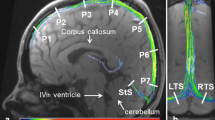Abstract
The internal jugular veins are considered to be the main pathways of cerebral blood drainage. However, angiographic and anatomical studies show a wide anatomical variability and varying degrees of jugular and non-jugular venous drainage. The study systematically analyses the types and prevalence of human cerebral venous outflow patterns by ultrasound and MRI. Fifty healthy volunteers (21 females; 29 males; mean age 27±7 years) were studied by color-coded duplex sonography. Venous blood volume flow was measured in both internal jugular and vertebral veins in the supine position. Furthermore, the global arterial cerebral blood volume flow was calculated as the sum of volume flows in both internal carotid and vertebral arteries. Three types of venous drainage patterns were defined: a total jugular volume flow of more than 2/3 (type 1), between 1/3 and 2/3 (type 2) and less than 1/3 (type 3) of the global arterial blood flow. 2D TOF MR-venography was performed exemplarily in one subject with type-1 and in two subjects with type-3 drainage. Type-1 drainage was present in 36 subjects (72%), type 2 in 11 subjects (22%) and type 3 in 3 subjects (6%). In the majority of subjects in our study population, the internal jugular veins were indeed the main drainage vessels in the supine body position. However, a predominantly non-jugular drainage pattern was found in approximately 6% of subjects.



Similar content being viewed by others
References
Huber P (1982) Cerebral angiography. Thieme, Stuttgart
Mueller HR, Hinn G, Buser MW (1990) Internal jugular venous flow measurement by means of a Duplex scanner. J Ultrasound Med 9:261–265
Gius JA, Grier DH (1950) Venous adaptation following bilateral radical neck dissection with excision of the jugular vein. Surgery 28:305–321
Valdueza JM, von Münster T, Hoffmann O, Schreiber S, Einhäupl KM (2000) Postural dependency of the cerebral venous outflow. Lancet 355:200–201
Cowan F, Thoresen M (1983) Ultrasound study of the cranial venous system in the human new-born infant and the adult. Acta Physiol Scand 117:131–137
Schreiber S, Lürtzing F, Götze R, Doepp F, Klingebiel R, Valdueza JM (2003) Extrajugular pathways of human cerebral venous blood drainage—assessed by duplex ultrasound. J Appl Physiol 94:1802–1805
Clarot F, Callonec F, Douvrin F et al (2000) Giant cervical epidural veins after lumbar puncture in a case of intracranial hypotension. AJNR Am J Neuroradiol 21:787–789
Schöning M, Walter J, Scheel P (1994) Estimation of cerebral blood flow through color duplex sonography of the carotid and vertebral arteries in healthy adults. Stroke 25:17–22
Scheel P, Ruge C, Petruch UR, Schöning M (2000) Color duplex measurement of cerebral blood flow volume in healthy adults. Stroke 31:147–150
Clemens HJ (1961) Die Venensysteme der menschlichen Wirbelsäule. Morphologie und funktionelle Bedeutung. Walter de Gruyter & Co, Berlin, pp 19–35
Lang J (1991) Klinische Anatomie der Halswirbelsäule. Thieme, Stuttgart, pp 104
Chou CH, Chao AC, Hu HH (2002) Ultrasonographic evaluation of vertebral venous valves. AJNR Am J Neuroradiol 23:1418–1420
Batson OV (1944) Anatomical problems concerned in the study of cerebral blood flow. Fed Proc 3:139–144
Eckenhoff JE (1970) The physiologic significance of the vertebral venous plexus. Surg Gynecol Obst 131:72–78
Fitz-Hugh GS, Robins RB, Craddock WD (1966) Increased intracranial pressure complicating unilateral neck dissection. Laryngoscope 76:893–906
Hacker H (1974) Normal supratentorial veins and dural sinuses. In: Newton TH, Potts DG (eds) Radiology of the scull and brain. Angiography. Mosby, St. Louis, pp 1851–1877
Wackenheim A, Braun JP (1978) The veins of the posterior fossa. Normal and pathological findings. Springer, Berlin Heidelberg New York, p 21
Ruíz DSM, Gailloud P, Rüfenacht DA, Delavelle J, Henry F, Fasel JHD (2002) The craniocervical venous system in relation to cerebral venous drainage. AJNR Am J Neuroradiol 23:1500–1508
Théron J, Djindjian R (1973) Cervicovertebral phlebography using catheterization. A preliminary report. Radiology 108:325–331
Shiu CP, Hanafee WN, Wilson GH, Rand RW (1968) Cavernous sinus venography. Am J Roentgenol Radium Ther Nucl Med 104:57–62
Hoffmann O, Weih M, von Münster T, Schreiber S, Einhäupl KM, Valdueza JM (1999) Blood flow velocities in the vertebral veins of healthy subjects: A duplex sonography study. J Neuroimaging 9:198–200
Dilenge D, Perey B (1973) An angiographic study of the meningorachidian venous system. Radiology 108:333–337
Müller HR (1985) Quantitative Bestimmung des Blutflusses in der Vena jugularis interna mittels Ultraschall. Ultraschall 6:51–54
Mueller HR, Casty M, Buser M, Haefele M (1988) Ultrasonic jugular venous flow measurement. J Cardiovasc Ultrasonogr 7:25–29
Wilson EM, Halsey JH (1970) Bilateral jugular venous blood flow by thermal dilution. Stroke 1:348–355
Wilson EM, Halsey JH, Vitek JJ (1972) Validation of jugular venous flow as an index of total cerebral blood flow. Stroke 3:300–321
Mélot C, Berré J, Moraine JJ, Kahn RJ (1996) Estimation of cerebral blood flow at bedside by continuous jugular thermodilution. J Cereb Blood Flow Metab 16:1263–1270
Bhadelia RA, Bogdan AR, Wolpert, SM (1998) Cerebrospinal fluid flow waveforms: effect of altered cranial venous outflow. A phase-contrast MR flow imaging study. Neuroradiology 40:283–292
Hoffmann O, Klingebiel R, Braun JS, Katchanov J, Valdueza JM (2002) Diagnostic pitfall: Atypical cerebral venous drainage via the vertebral venous system. AJNR Am J Neuroradiol 23:408–411
Author information
Authors and Affiliations
Corresponding author
Additional information
This study was presented in part as an oral presentation at the 8th Meeting of Neurosonology and Hemodynamics, Alicante, Spain, 18–21 May 2003.
Rights and permissions
About this article
Cite this article
Doepp, F., Schreiber, S.J., von Münster, T. et al. How does the blood leave the brain? A systematic ultrasound analysis of cerebral venous drainage patterns. Neuroradiology 46, 565–570 (2004). https://doi.org/10.1007/s00234-004-1213-3
Received:
Accepted:
Published:
Issue Date:
DOI: https://doi.org/10.1007/s00234-004-1213-3




